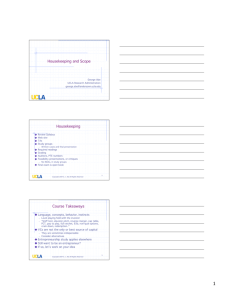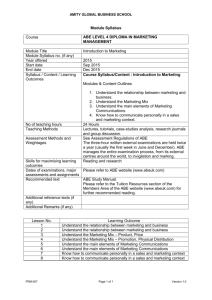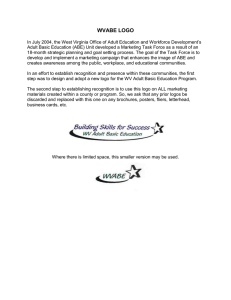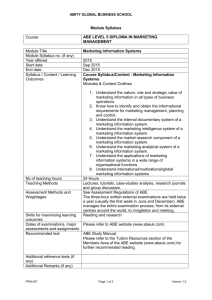Corporate Finance and Human Resource Management: Evidence from Changing
advertisement
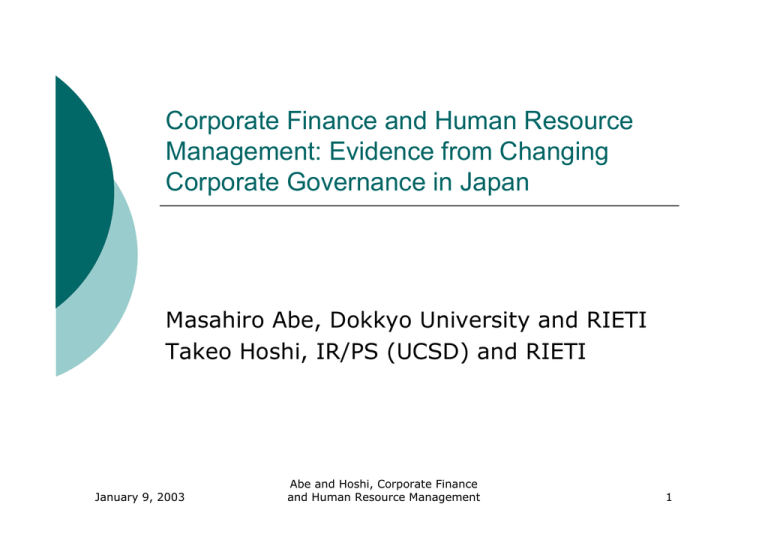
Corporate Finance and Human Resource
Management: Evidence from Changing
Corporate Governance in Japan
Masahiro Abe, Dokkyo University and RIETI
Takeo Hoshi, IR/PS (UCSD) and RIETI
January 9, 2003
Abe and Hoshi, Corporate Finance
and Human Resource Management
1
Corporate Governance
{
{
{
{
January 9, 2003
Stakeholder view of corporate governance
Design of institutions that induce or force
management to internalize the welfare of
stakeholders (Tirole 2001)
Set of self-enforcing rules that regulates
action choices of the players (manager,
investor and worker) contingent on
evolving states (Aoki)
Whether firms are operated in the interests
of stakeholders, including employees and
customers as well as shareholders (Allen
and Gale)
Abe and Hoshi, Corporate Finance
and Human Resource Management
2
Corporate governance has various
aspects, including
{
{
{
January 9, 2003
Corporate finance
Human resources management
Customer relationship
Abe and Hoshi, Corporate Finance
and Human Resource Management
3
Complemantarity in Corporate
Governance
{
{
January 9, 2003
As Masahiko Aoki has pointed out, the
aspects of corporate governance may be
complementary to each other.
For example,
z Corporate financing and human resource
management
z Corporate financing and customer
relationship
Abe and Hoshi, Corporate Finance
and Human Resource Management
4
Corporate finance and human resource
management: complemantarity
{
{
January 9, 2003
Bank loans may be easier to be
renegotiated under financial distress
(compared with bond financing)
Conducive to human resource
management that depends on longterm relationship (e.g., investment
in firm specific skills encouraged by
seniority wages)
Abe and Hoshi, Corporate Finance
and Human Resource Management
5
“Japanese” corporate governance
{
{
{
January 9, 2003
Fits the stakeholder view
Characterized by long-term relationship
with:
z Main banks
z Stable shareholders
z Lifetime employees
z Keiretsu customers/suppliers
But, has been changing since the late
1970s
Abe and Hoshi, Corporate Finance
and Human Resource Management
6
Changes in corporate financing
{
{
{
{
{
January 9, 2003
Following the financial deregulation from
the late 1970s
Reduced dependence on bank loans
Increased dependence on market (bond)
financing
(more recently) declining crossshareholdings
Increased presence of foreign ownership
Abe and Hoshi, Corporate Finance
and Human Resource Management
7
Bank Debt / Total Assets
for large manufacturing firms (%)
40
35
30
25
20
15
1975
1976
1977
1978
1979
1980
1981
1982
1983
1984
1985
1986
1987
1988
1989
1990
1991
1992
1993
1994
1995
1996
1997
10
January 9, 2003
Abe and Hoshi, Corporate Finance
and Human Resource Management
8
Unwinding cross-shareholding (%)
Average proportion of shares in a company held by the companies
whose shares are also held by the company (NLI Research Institute)
20
18
16
14
12
10
January 9, 2003
Abe and Hoshi, Corporate Finance
and Human Resource Management
2001
2000
1999
1998
1997
1996
1995
1994
1993
1992
1991
1990
1989
1988
1987
8
9
Foreign ownership (% of market value,
Tokyo Stock Exchange)
January 9, 2003
Abe and Hoshi, Corporate Finance
and Human Resource Management
20
01
19
99
19
97
19
95
19
93
19
91
19
89
19
87
19
85
20
18
16
14
12
10
8
6
4
2
0
10
Changes in Human Resource
Management
{
{
{
January 9, 2003
The lifetime employment, the seniority
wage system, and firm specific training,
characterized the “Japanese” human
resource management
" Japanese HRM system" have been
changing since the early 90s
For example, according to the survey
conducted by Japan Institute of Labour in
1996, more companies plan to weaken the
lifetime employment and seniority wage
system
Abe and Hoshi, Corporate Finance
and Human Resource Management
11
Changes in Human Resource
Management
{
Increasing labor market mobility (decline of
lifetime employment system)
z
z
{
{
January 9, 2003
Faster employment adjustment
Growing number of part-timers
Increased adoption of job-based pay scale
(decline of seniority wages)
Expansion of salary gap
Abe and Hoshi, Corporate Finance
and Human Resource Management
12
Speed of employment adjustment
Speed of
# of periods to
employment
reach the
adjustment
optimum
Period
1977II - 85II
85III - 91I
91II - 2000IV
0.199
0.197
0.213
5
5.1
4.7
Source: White Paper of Labor Economics
2002 (MHLW)
January 9, 2003
Abe and Hoshi, Corporate Finance
and Human Resource Management
13
Growing proportion of part-time
workers (% of all employees)
25
20
15
10
5
0
1970
January 9, 2003
75
80
85
90
Abe and Hoshi, Corporate Finance
and Human Resource Management
95
2000
2001
14
Proportion of firms that have introduced
job-based pay scales
January 9, 2003
Year
type of worker
% of firms
that have
job-based
pay scales
1983
All employees
28.3
1989
All employees
24.5
1998
Managers
48.6
Non-managers
47.9
Abe and Hoshi, Corporate Finance
and Human Resource Management
15
Among the firms with salary structures
that reflect individual performances
In the last 5 years
Increased the
salary range
Reduced the
salary range
For managers
41.3%
8.4%
For non-managers
39.5%
9.8%
In the next 3 years
Plan to increase
the salary range
Plan to reduce
the salary range
For managers
51.2%
3.2%
For non-managers
49.2%
4.0%
Source: Survey on Employment Condition (MHLW)
January 9, 2003
Abe and Hoshi, Corporate Finance
and Human Resource Management
16
Are these changes linked?
{
{
{
January 9, 2003
This project proposes to examine the
relation between the change in corporate
financing and the change in human
resource management for Japanese firms
We seek the evidence for complementarity
between financial aspect of corporate
governance and human resource
management
Note: we study the complementarity at the
firm level, not at the system level
Abe and Hoshi, Corporate Finance
and Human Resource Management
17
Data
1.
2.
January 9, 2003
DBJ Corporate Financial Data
(Development Bank of Japan)
Survey on the Human Resource
Management Systems (Romu Gyosei
Kenkyu-jo)
Abe and Hoshi, Corporate Finance
and Human Resource Management
18
Survey on the Human Resource
Management Systems
{
{
{
January 9, 2003
Conducted in spring 2001
Sample includes;
(1) 3440 listed companies
(2) 352 large but unlisted companies
(3) 2582 medium sized companies that
employ more than 100 employees
621 companies returned the survey
Abe and Hoshi, Corporate Finance
and Human Resource Management
19
Matching data
{
{
{
January 9, 2003
Corporate financial data covers all nonfinancial listed firms
Corporate financial data are matched with
the human resource management data
For 130 companies, we have data in both
databases
Abe and Hoshi, Corporate Finance
and Human Resource Management
20
Preliminary results
{
{
January 9, 2003
Some evidence that firms that deviate from
lifetime employment practice tend to have
low dependence on bank financing and/or
to be owned more by foreign investors
Some evidence that firms that value
individual performance (rather than group
performance) of the employees (thus
deviating from seniority wages) tend to
have low dependence on bank financing
and/or to be owned more by foreign
investors
Abe and Hoshi, Corporate Finance
and Human Resource Management
21
Flex-time system
{
Firms with “flex-time” system tend to have
low bank dependence and high foreign
ownership
Bank loan /
total debt
% owned by
foreigners
January 9, 2003
Has flextime (94
firms)
0.22
7.74
No flextime (83
firms)
0.28
3.20
Abe and Hoshi, Corporate Finance
and Human Resource Management
P-value
for the
difference
0.0406
0.0003
22
Awards for continued services
{
Firms that award the employees with long
continued services tend to have low foreign
ownership
Has awards No awards P-value
(137 firms) (40 firms) for the
difference
% owned by
4.92
7.98
0.0446
foreigners
January 9, 2003
Abe and Hoshi, Corporate Finance
and Human Resource Management
23
Financial rewards for inventions
{
Firms that give financial rewards to
individual employees who come up with
inventions tend to have low bank
dependence and high foreign ownership
Bank loan /
total debt
% owned by
foreigners
January 9, 2003
Has
rewards
(69 firms)
0.20
7.21
No rewards P-value
(108 firms) for the
difference
0.29
0.0037
4.59
Abe and Hoshi, Corporate Finance
and Human Resource Management
0.0448
24
(near) Future agenda
{
{
{
January 9, 2003
Suggestive but inconclusive
evidence so far
Examination with more controls
(e.g., size, industry)
Try to find the relation between
“changes”
Abe and Hoshi, Corporate Finance
and Human Resource Management
25

